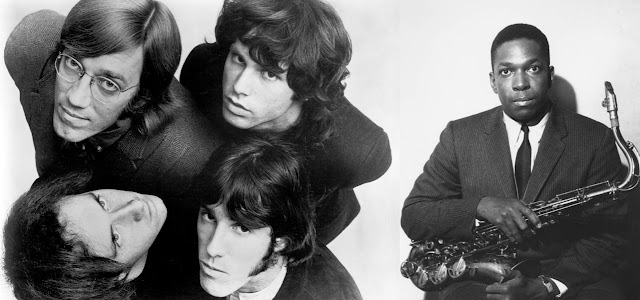5 FAMOUS DEATHS ON THE ROAD TO "STRANGE DAYS" (PART 3)
The third episode in this series of articles about the
five famous deaths that accompanied the recordings of the Doors' second album
("Strange Days", September 1967) deals with a great artist.
He left us on July 17, 1967 at the age of 40, when the
"Strange Days" sessions were already in full swing. We are talking
about the great jazz saxophonist John Coltrane.
His connection to the Doors is underlined by several
instrumental passages that the band incorporated into their songs, especially
early in their career. These include Robby Krieger's electric guitar solo on
"Light My Fire" as well as many of Manzarek's live organ solos.
Coltrane was a respected and beloved figure among the
members of the California group, which fell under his artistic spell and felt his
influence both in studio and concerts. More than one interview confirm the appriciation The Doors had for this great jazz musician.
The artistic path of this genius can be divided into
three stages. Leaving aside his musical apprenticeship in rhythm and blues
bands in the early 1950s, the first phase is that inherent the Hard Bop style
of jazz.
This phase of the saxophonist’s career goes from 1955
to 1959. At this stage he played only the tenor saxophone while his style was
already unmistakable; as an example we cite "Rise and Shine",
recorded in March 1958 with other excellent musicians.
In this first part of his career, Coltrane developed
the tenor saxophone style known as the "Sheet of sound", which stands
for the overwhelming cascade of notes produced by his instrument, yet in an understandable
and immediate way.
The second phase runs from 1960 to 1964 and enters the
more sophisticated terrain of Modal Jazz. In this context, we mention the track
"Acknowledgement" from the LP "A Love Supreme",
recorded in December 1964. At this time, he also introduced the soprano
saxophone for his improvisations and formed a stable quartet with three other
great jazz musicians.
The last phase, from 1965 until his death in July ‘67,
is one of experimentation without formal restrictions, which takes him into the
domain of Free Jazz. The piece we have chosen to illustrate this period is
"Sun Ship", recorded in August 1965 and taken from the
posthumous album of the same name.
To end this article, we affirm that John Coltrane was a
milestone in the history of jazz as well as music in general. He was an admired
musical icon and a significant inspiration for The Doors as well.




Comments
Post a Comment